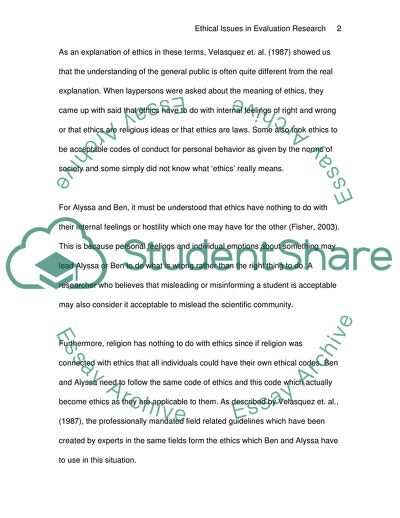
- Home
- Free Samples
- Premium Essays
- Editing Services
- Extra Tools
- Essay Writing Help
- About Us
- Studentshare
- Subjects
- Miscellaneous
- Ethical Issues in Evaluation Research
Ethical Issues in Evaluation Research - Essay Example

- Subject: Miscellaneous
- Type: Essay
- Level: Masters
- Pages: 4 (1000 words)
- Downloads: 0
- Author: keaganrutherfor
Extract of sample "Ethical Issues in Evaluation Research"
In scientific terms, ethics becomes a part of philosophy that discusses individual and social behavior in terms of being right and wrong or good and evil. In a professional field such as research, education and teaching, the application of ethical principles can be said to be a part of the essential practices which create and develop the credibility of a person or an academic body organization (Puma Expert Group, 2002). As an explanation of ethics in these terms, Velasquez et. al. (1987) showed us that the understanding of the general public is often quite different from the real explanation.
When laypersons were asked about the meaning of ethics, they came up with said that ethics have to do with internal feelings of right and wrong or that ethics are religious ideas or that ethics are laws. Some also took ethics to be acceptable codes of conduct for personal behavior as given by the norms of society and some simply did not know what ‘ethics’ really means. For Alyssa and Ben, it must be understood that ethics have nothing to do with their internal feelings or hostility which one may have for the other (Fisher, 2003).
This is because personal feelings and individual emotions about something may lead Alyssa or Ben to do what is wrong rather than the right thing to do. A researcher who believes that misleading or misinforming a student is acceptable may also consider it acceptable to mislead the scientific community. Furthermore, religion has nothing to do with ethics since if religion was connected with ethics that all individuals could have their own ethical codes. Ben and Alyssa need to follow the same code of ethics and this code which actually become ethics as they are applicable to them.
As described by Velasquez et. al., (1987), the professionally mandated field related guidelines which have been created by experts in the same fields form the ethics which Ben and Alyssa have to use in this situation. Using such a
...Download file to see next pages Read More
- TERMS & CONDITIONS
- PRIVACY POLICY
- COOKIES POLICY